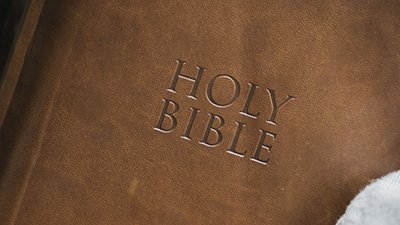The Da Vinci Code: Secret Hidden Truth?
A Best Seller Rewrites the Truth About the Bible
The Devil is a liar and the father of lies, and the heart of man is deceitful above all things, and desperately corrupt.
The Devil is a liar and the father of lies, and the heart of man is deceitful above all things, and desperately corrupt. Put the two together and you get a very toxic mix indeed.
We must expect, therefore, that the enemies of God will try every strategy possible to discredit the Bible. The latest best-selling book in this mould (claimed on the author’s website to be one of the most widely read books of all time) is The Da Vinci Code, by Dan Brown. The film rights have already been sold to Sony Pictures and a top director has been engaged to produce the film in 2005.
To the casual reader, it is nothing more than good fiction—a murder mystery that pits the keepers of the Holy Grail against Opus Dei—the “keepers” of the Catholic church. So why the outcry? Well, one reason is that the first page makes a bold statement that the novel is based on historical fact—‘all descriptions of artwork, architecture, documents and secret rituals in this novel are accurate” [emphasis mine]. At least one critic agrees and says “his research is impeccable.”
Impeccable research?
But impeccable it is not. For example, one of the heroes is an eminent historian called Sir Leigh Teabing. He says, “To fully understand the Grail, we must first understand the Bible … The Bible did not arrive by fax from heaven … [it] is a product of man … not God … and it has evolved through countless translations, additions and revisions. History never had a definitive version of the book. … Jesus Christ was a historical figure of staggering influence … his life was recorded by thousands of followers … more than eighty gospels were considered for the New Testament … Who chose which gospels to include? … The Bible, as we know it today, was collated by the pagan Roman emperor Constantine” (p.231). The plethora of historical fallacies continues unabated but this one-page sample is sufficient to illustrate the point.
The Bible testifies of itself that it is indeed “God-breathed
” (2 Timothy 3:16). Men moved by the Holy Spirit spoke from God (2 Peter 1:21), and Jesus said “Heaven and earth will pass away, but my words will not pass away
” (Matthew 24:35; Mark 13:31; Luke 21:33). Neither has its meaning been lost or corrupted through “countless translations.” The original languages were Hebrew (OT, with a few sections in Aramaic) and Greek (NT). Modern English versions, for example, are based on meticulously prepared composites of ancient Greek and Hebrew manuscripts, of which thousands are extant. The Dead Sea Scrolls showed that copies of OT books from the first century BC were almost identical to the previously earliest Hebrew manuscripts from a thousand years later, so copying errors have not been a significant problem.
No major doctrine is in any way obscured by manuscript differences.
History certainly has had a “definitive version”. The Latin Vulgate remained the definitive version for over a thousand years, and the subsequent divergence between Protestant and Catholic versions was based primarily on theological principles, not manuscript problems. The content of the modern Protestant and Catholic Bibles, except for the few differences in the Old Testament, is all based on similar manuscript evidence. No major doctrine is in any way obscured by manuscript differences. Indeed, the very abundance of similar ancient manuscripts points unerringly to similar original sources.
It is misleading to say that Jesus Christ was an “historical person of staggering influence whose life was recorded by thousands of followers.” He was at that time an obscure carpenter who lived and died within walking distance of His birthplace in a backwater of the Roman Empire. His “staggering influence” did not emerge until centuries later, as did the numerous false gospels—after all, there is no point in emulating a nobody. As for Constantine making the choice of Matthew, Mark, Luke and John, the idea is laughable.
The gathering of the New Testament documents began within the first century. Paul referred to Luke’s Gospel as “scripture
’—graphè (1 Tim 5:18 cites both Deut. 25:4 and Luke 10:7 as such). Peter recognized that Paul’s writings were “scripture
’—in 2 Peter 3:15–17 he refers to them as authoritative and then refers to “the other scriptures
,” and he warns his readers to beware of those who twist the meanings to their own destruction.
This process of recognizing the true and separating it from the false gained momentum in the second century when the heretic Marcion produced his own, very reduced, list of authorized books. Since the caricature always comes after the original, this implies that the main features of the NT collection were in place at that time. By the time of the Council of Nicaea in AD 325 (which Constantine convened, but it was the gathering of 318 bishops that made the decisions) the issue was not even debated. The deliberations of the Council focused on the deity of Christ, and the authority of the four gospels on that subject was taken for granted by all the bishops present. The final statements regarding formal recognition of the 27 books of the New Testament that we have today (what we call the Canon) were made at African synods (at Hippo and Carthage) in AD 393 and 397.1
It’s important to note that the Canon was decided by God and merely recognized by man. Leading NT scholar F.F. Bruce put it well:
“The NT books did not become authoritative for the Church because they were formally included in a canonical list; on the contrary, the Church included them in her canon because she already regarded them as divinely inspired, …. [Church] councils [did] not impose something new upon the Christian communities but codif[ied] what was already the general practice of those communities.”2
One of the world’s greatest authorities on the Greek New Testament, Bruce Metzger, pointed out:
“You have to understand that the canon was not the result of a series of contests involving church politics. … . You see, the canon is a list of authoritative books more than it is an authoritative list of books. These documents didn't derive their authority from being selected; each one was authoritative before anyone gathered them together.”3
(See Q&A: Bible for the truth about the Bible’s inerrancy and Canon).
Errors—so what?
But surely other fictional books have made equal4ly ignoble historical blunders—why worry about this one? Well, this one puts together a “conspiracy theory” with the help of some very powerful (and almost believable) real-life players—Leonardo Da Vinci, Opus Dei, and modern goddess-worshipping “historians” who prefer the faked gospels to the real thing. You see, the Holy Grail turns out not to be a chalice, but a person. The Holy Grail is a woman—Mary Magdalene—who married and bore children to Jesus. And there she is, for all the world to see, in Leonardo’s famous painting of The Last Supper—in the place of honour, at Jesus’ right hand (check it out for yourself).5
Brown uses his skill in fiction to weave an enticing tale about Jesus’ humanity, which allegedly necessarily includes marriage (and thus, they claim, denial of His deity).
For the more knowledgeable, the story really falls apart when Brown claims the Gospel of Mary Magdalene to be an “unaltered” (p.248) and therefore true account of these events (yet even the words he quotes from it betray its fraudulence). However, this Gnostic “gospel” is known only from three fragmentary manuscripts, and dates from the middle of the second century at the earliest. Before this or any other Gnostic “gospel” was written, the church far and wide recognized the authority of the four canonical gospels. But a less knowledgeable soul might easily be duped.
Meanwhile, Opus Dei—a powerfully influential Catholic order—knows that their “secret” is about to be exposed and they are determined to silence the investigation—thus the murders. There follows a fanciful reconstruction of Christian history to explain why the original “true” Christianity—which they say was a goddess cult—was displaced by the “misogynist patriarchal” version we have today.
The value of history
Here is where we need to consider: what is our faith based upon—revealed truth, or secret hidden truth? My faith is based upon revealed truth, in a written tradition that goes back to Moses (indeed, to Adam—Genesis 5:1). Just before he died, Moses told the Israelites:
“
The secret things belong to the LORD our God; but the things that are revealed belong to us and to our children for ever, that we may do all the words of this law … For this commandment which I command you this day is not too hard for you, neither is it far off. It is not in heaven, that you should say, ‘Who will go up for us to heaven, and bring it to us, that we may hear it and do it?" Neither is it beyond the sea, that you should say, ‘Who will go over the sea for us, and bring it to us, that we may hear it and do it?’ But the word is very near you; it is in your mouth and in your heart, so that you can do it.” (Deuteronomy 29:29; 30:11–14).
The reason it was near to them was because God ensured it was written down for them (Exodus 31:18; Deuteronomy 31:9–13, 24–29).
There is no room in Christianity for hidden fundamentals. Hidden depths, certainly, but God has made the fundamentals clear to us in writing so that we are without excuse if we do not heed His Word. According to Jesus, the standard of judgment is the Word He has already spoken to us (John 12:48). It logically follows that God will have provided a reliable record of that word for us, and true history testifies that it is so. But beware of gifted novelists able to use their God-given talents in an attempt to undermine and deny His Word.
Footnotes
- Schaff, P., History of the Christian Church, Vol.II Ante-Nicene Christianity A.D. 100–325, Eerdmans Publishing Co., Grand Rapids, 1910 & 1992, Ch. 138, pp. 516–524.
- Bruce, F.F., The New Testament Documents: Are they reliable? IVP, Downers Grove, Illinois, 1960.
- Metzger, B., interviewed in Strobel, L., The Case for Christ, Zondervan, Grand Rapids, MI, 1998.
- /get-answers/topic/bible
- Leonardo Da Vinci was a brilliant 15th century artist and technological genius, not a Bible scholar, and he is described in the book as a “trickster.” His curious painting displays artistic license, not necessarily biblical truth.

Answers in Genesis is an apologetics ministry, dedicated to helping Christians defend their faith and proclaim the good news of Jesus Christ.
- Customer Service 800.778.3390
- Available Monday–Friday | 9 AM–5 PM ET
- © 2025 Answers in Genesis




